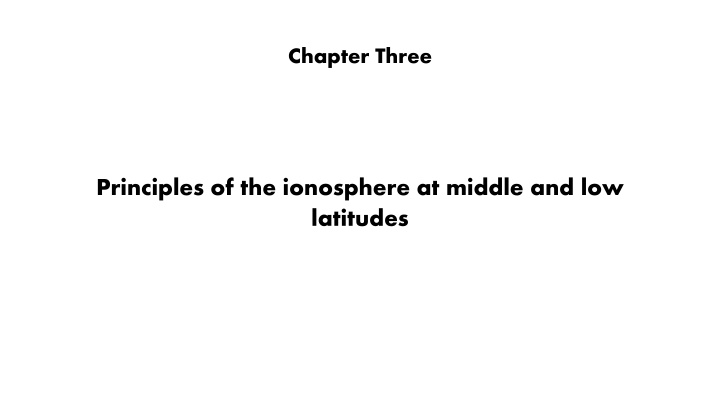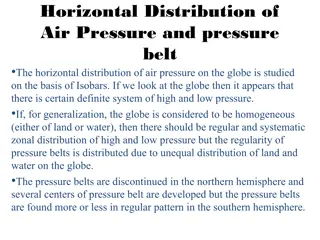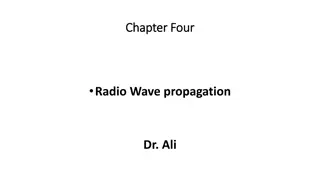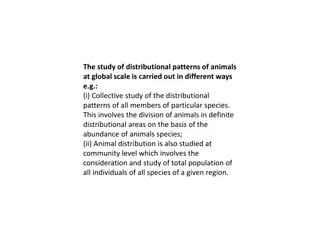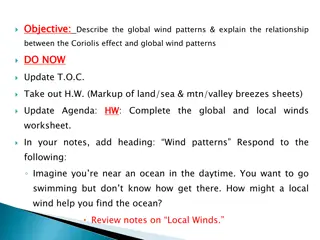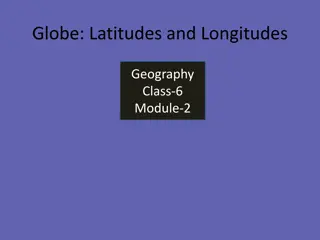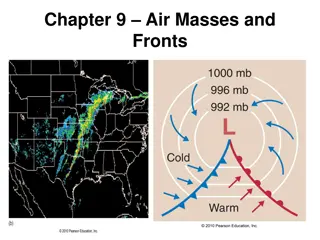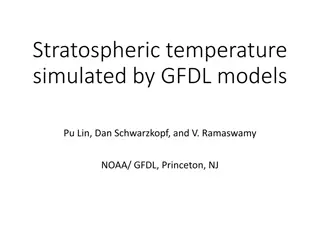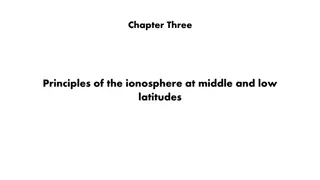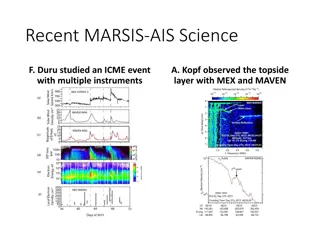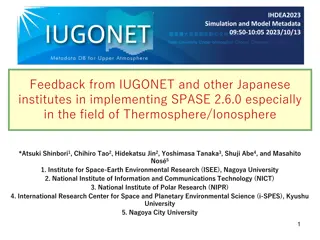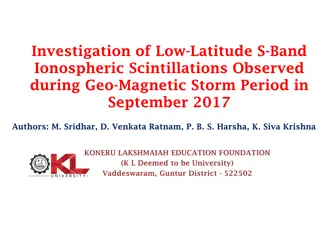Principles of the Ionosphere at Middle and Low Latitudes
Principles of chemical recombination in the ionosphere at middle and low latitudes are discussed, focusing on the loss of electrons, recombination between ions and electrons, attachment to neutral particles, peak electron density variation, and relaxation time calculations.
Download Presentation

Please find below an Image/Link to download the presentation.
The content on the website is provided AS IS for your information and personal use only. It may not be sold, licensed, or shared on other websites without obtaining consent from the author.If you encounter any issues during the download, it is possible that the publisher has removed the file from their server.
You are allowed to download the files provided on this website for personal or commercial use, subject to the condition that they are used lawfully. All files are the property of their respective owners.
The content on the website is provided AS IS for your information and personal use only. It may not be sold, licensed, or shared on other websites without obtaining consent from the author.
E N D
Presentation Transcript
Chapter Three Principles of the ionosphere at middle and low latitudes
Principles of chemical recombination 1. Two important factors for the loss of electrons. These are a. one for the recombination between ions and electrons to reform neutral particles, and b. The other to account for movement of plasma into or out of the volume 2. We deal first with the principles of chemical recombination. 3. First we assume that the electrons recombine directly with positive ions and that no negative ions are present: X++ e X. Then the rate of electron loss is ? = ? ?+? = ??2
Where N is the electron density (equal to the ion density [X+]) and ? is the recombination coefficient.At equilibrium, therefore, ? = ??2 Taking the production rate q from the Chapman production function 3, we obtain ? = ???exp1 2( 1 ? sec ? exp ? ) in which z = (h -ho)/H. And from Equation 4 it is seen that the electron density at the peak of the layer varies as ???1/2? ??= ??????1/2(?) a layer with these properties is called an -Chapman layer.
4. If one is concerned particularly with electron loss, then attachment to neutral particles to form negative ions can itself be regarded as another type of electron loss process. We can see that the attachment type of reaction can be written M + e M- And the rate of electron loss (due to attachment) is L = N Where is the attachment coefficient.At equilibrium, q = N Taking q from the Chapman production function, as before, gives ? = ???exp(1 ? sec ? exp ? ). The peak electron density now varies as: ??= ?????? (?) Such a layer is a -Chapman layer.
In fact is expected to vary with height because it depends on the concentration of the neutral molecules (M). 5. The relaxation time tris the time in which the electron density world reduce to half if there was no more production of electrons. Setting q=0 in the continuity equation and neglecting attachment and diffusion we have ?? ??= ??2 Solving this simple differential equation, we find that the time trin which N (tr) becomes No/2 1 ??= ???
Chemical Description Introduction 1. The composition of the neutral atmosphere is composed mainly of the nitrogen/oxygen mixture generally known as 'air' up to about 100 km, and above that the atomic species O, He, and H progressively enter the scene due to diffusive separation. 2. To be ionized, a species must absorb a quantum of radiation whose energy exceeds the ionization potential. Table 1 lists the ionization potential and the corresponding maximum wavelength maxof radiation able to effect an ionization for various atmospheric gases. 3. Only radiation of wavelength less than maxcan produce ionization.
4. These values of maximmediately identify the relevant parts of the solar spectrum as the: X-ray (0.1-17 nm, 1-170 A) and Extreme ultra-violet, EUV, (17-175 nm, 170- 1750 A), emissions which come from the solar chromosphere and corona. Some are enhance during flares. Table (1) Ionization potentials
5. However, not every photon with sufficient energy will actually produce an ionization. The chance that the photon will be absorbed is given by the absorption cross section ( sigma) and the chance that absorbed photon produces an ionization is given by the ionization efficiency ( Eta). The product ( ) is called the ionization cross section ( i). 6. In the Chapman formulation the value of the absorption cross section, , generally increases with increasing wavelength up to maxand then falls rapidly to zero. Figure 4 shows how ( ) depends on wavelength for some common gases.
7. The efficiency with which the absorbed radiation leads to ionization is expressed by the ionization efficiency, . With atomic species, all the absorbed energy goes into ion-electron production, =1, at the rate of one ion-electron pair for every 34 eV of energy. 8. For molecules <1, 360 ?(??) = 9. The intensity of solar radiation decreases due to absorption as it passes through the atmosphere. The peak of ionization production occurs at that altitude where the intensity has been reduced to 1/e times the intensity at the top of the atmosphere (Im= I /e). The intensity is then said to reach one optical depth at the peak of production.
